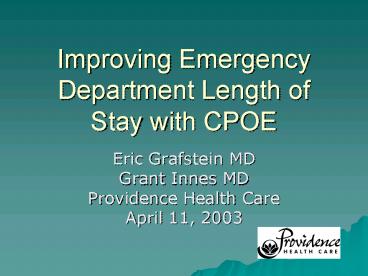Improving Emergency Department Length of Stay with CPOE - PowerPoint PPT Presentation
1 / 48
Title:
Improving Emergency Department Length of Stay with CPOE
Description:
Review the reasons for implementing POE in the St. Paul's Hospital Emergency ... 18 FTEs locum pool. CCFP (EM) training program. Extensive research program ... – PowerPoint PPT presentation
Number of Views:84
Avg rating:3.0/5.0
Title: Improving Emergency Department Length of Stay with CPOE
1
Improving Emergency Department Length of Stay
with CPOE
- Eric Grafstein MD
- Grant Innes MD
- Providence Health Care
- April 11, 2003
2
Objectives
- Review the reasons for implementing POE in the
St. Pauls Hospital Emergency Department - Discuss the clinical impact of POE on critical ED
process indicators (LOS).
3
Who are we? - St. Pauls Hospital
- 450 bed tertiary care teaching and research
- Inner city primary and secondary care
- Regional tertiary and quaternary care
- Clinical foci include HIV, cardiology, renal,
transplantation, psychiatry
4
The ER St. Pauls Hospital
- 48,000 visits/year
- 18 FTEs locum pool
- CCFP (EM) training program
- Extensive research program
- Academic interests broadly include ED
cost-effectiveness, acute coronary syndrome,
inner city medicine
5
Why CPOE in the ED?
- Reducing the cost of care?
- Providing maximal health benefit with the
resources available - Overcrowding inability to provide care
- Profound system limitations mandate efficient ED
utilization - Data/Research needs
6
(No Transcript)
7
Waiting Room Care (percent of total visits)
(34)
(27)
(31)
(24)
8
Waiting time (hrs) from admission to ward transfer
9
Our needs
- ADT system outdated - unidirectional
- Unable to assign patient accurately to individual
physician - Unable to track orders on individual patients
- Missing key time processes.
10
How well did our implementation go?
- 100 physician support/satisfaction
- Good nursing support and increased computer
contact/medication ordering by nurses for verbal
orders - ? 100 lab and imaging orders.
- 80 physician log on for patients
- gt 75 of all medications ordered into SCM by
physicians
11
CPOE Implementation Reasons for Success
- Competent/Engaged IT support
- Physician champions
- Physician/Nursing/Unit Clerk buy in
- Well thought out CQI model involving all
stakeholders - Stakeholders had a voice feedback.
- Staged Implementation
- Small, stable environment
- Vendor support
12
MD Orders X-ray Chest in SCM
MD sees Pt with Chest Pain
XR Technologist paged STAT XR EDSTR01 Pt
OMalley Rx Chest Pain
Exam Performed Result available in SCM
13
Case Chest Pain
- A 66 year old man complains of vague substernal
indigestion and nausea. He has a history of
diabetes and hypertension. - P96, R18, BP160/90. Physical exam is
unremarkable. Nurses have performed an initial
ECG, which is non-diagnostic.
14
Investigations / Rx?
-CBC, -Electrolytes, -Troponin,
-Amylase -CXR -Rpt ECG in 2 hrs Medications -ASA
, -Metoprolol, -Enoxaparin, -Morphine, -Compazin
e
15
Case 2 Chest Pain
16
Case 2 Time Seen Seen By
17
Case 2 Ready to Order
18
Order Browser ACS Protocol
19
Case 2 Acute Coronary SyndromeOrder Set
20
Case 2 Medications
21
Case 2 Enoxaparin Order
22
Case 2 GI Metabolic Orders
23
Case 2 GI Metabolic Orders
24
Case 2 Amylase Order
25
Case 2 Orders Submitted
26
Case 2 Results Are In
27
Case 2 ECG Results
28
Two-hour ECG
29
Browser screen Consult
30
Consult CCU
31
Evaluating the Impact of POE on Clinical Processes
- Objective
- To determine the effect of physician order entry
on ED processes - Hypothesis
- Fewer people and steps in the order entry
process will reduce time-to-test and ED LOS by
gt10
32
Methods (Before-After study)
- Before Retrospective Chart Review
- Patients 200 randomly-selected patients with
level 3 abdominal pain seen between June 1-Oct 1,
2000 - Data collection Treating physician, pt.
demographics, critical time points, disposition,
tests ordered, LOS. Data manually entered into an
Excel spreadsheet. - After Electronic Report Generation
- Patients All patients with level 3 abdominal
pain seen between June 1-Oct 1, 2001 (n864) - Data collection Data elements gathered
electronically
33
Results Patient Characteristics
34
(No Transcript)
35
Critical Process Times
36
OLD WAY
NEW WAY
100 patients
100 patients
MD
Waiting Room
Waiting Room
Wait n100
Wait N50
Dischg n70
To stretcher
Dischg n70
MD
To stretcher
Admit n30
Admit n30
37
Does POE Reduce ED Length Of Stay (LOS) In An
Overcrowded ED?
- Hypothesis The change to POE would reduce ED
LOS, especially for patients treated in the WR. - Method A controlled before-after study at SPH.
- Before cohort All patients discharged from the
SPH ED from June 10-Nov 10, 2000. - The POE (after) cohort All patients discharged
from June 10-Nov 10, 2001.
38
Does POE Reduce ED Length Of Stay (LOS) In An
Overcrowded ED?
- Concurrent control data was gathered from a
nearby teaching hospital with similar volume and
triage mix that did not implement POE. - Primary outcome ED LOS for discharged patients.
39
Results
- Similar age, disease spectrum, gender, acuity
between the two groups - ED gridlock and overcrowding increased during the
study period - Daily admitted patients held in ED rose from 17.6
to 20.7 - ED LOS for admitted patients rose from 11.6 to
31.5 hours
40
Results
- Outcomes Before After
- SPH ED LOS (hrs) 2.4 2.6
- Control hospital LOS 3.6 4.2
- SPH LOS for WR pts 3.4 3.1
P lt .001
41
Length of ER Visit (hrs)Vancouver Regional
Emergency Services Planning Group Data (2002)
for patients being discharged
42
Comparison of Triage Acuity
43
CERVICAL STRAIN by MDNov/01 Nov/02
Total patients
N 228
No. pts x-rayed
44
Treatment Times ED LOS for Cervical Strain by MD
Treatment Time (MIN)
N 228
ED LOS (MIN)
45
HEADACHE MIGRAINE
46
HEADACHE MIGRAINE (NO CT and/or NO LP)
47
(No Transcript)
48
Pitfalls to Avoid
- CPOE cures cancer
- CPOE one size fits all
- I dont know the question but CPOE is definitely
the answer
49
(No Transcript)

